If the "munitions dispenser" and the LGB is in widespread service, then it doesn't seem that PGMs are being ignored much.
Arguably, the most important 'PGM' you can have is that "munitions dispenser," because it allows you to hit all the following targets:
- Radar/SAMs for DEAD (much more effective than ARMs, according to USAF Wild Weasel pilots.)
- Airbases
- Ground Attack (inf/mech/armor/convoys)
The only thing they can't hit is any kind of infrastructure or hardened targets (unless you have a unitary warhead option like the JSOW-C). And for the rest, the 500kg LGB is good for precision. Satt-guided would be good too, but remember satt-guidance has jamming issues against advanced opponents (and there's always some niche bombs, like bunker busters etc. but you don't need too many of those.)
Along with the "munition dispensers" + LGBs, if the PLA is building/maintaining a sufficient inventory of CMs and ALCMs, I'd say it's in a good place. Personally, I think CMs/ALCMs should be the highest priority, then munition dispensers, followed by LGBs/JDAMs.
The only widespread PGM in PLA service is the 500kg LGB.
The 500kg munitions dispenser and 100kg LGB/satenav bomb might have begun introduction in service, I would say these two are respectively in the "Initial Service Fielding/Tactics" phase.
Of course, if both of those can be proliferated in large numbers, that would be a significant boost in capability.
However, the reason why I am very much unimpressed by the 500kg LGB (and also the 100kg LGB/satnav bomb so far) is because of multiple ejector racks.
Let me demonstrate what I mean:
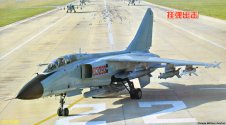
This is a JH-7/A with four 500kg LGBs. It's got a central EFT, a targeting pod, and four SRAAMs. Not bad right?
But that's only four targets it can engage.
But those pylons are rated for much more than 500kg in payload, and 500kg is also overkill for most targets you'd be interested in engaging.
Here's a JH-7/A carrying 250kg unguided bombs --
twenty of them:
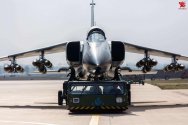
Those pylons are rated for that much weight. Imagine if those 250kg bombs were 250kg PGMs instead.
Sure, realistically using all four of the inner wing pylons for bombs is a bit much -- realistically you'd probably have three EFTs (one central, two underwing) -- but on a JH-7/A, that still leaves you with the two inner wing stations to carry
twelve 250kg PGMs.
And we see the same for other aircraft, like J-10s (here with what looks like
eight 250kg class bombs, four on dual multi racks and four on fuselage stations)...
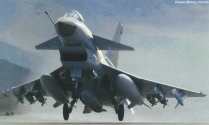
.... H-6Ks, here seen carrying
thirty six 250kg class bombs, six bomb per multi-ejector rack on each of its six weapons pylons...
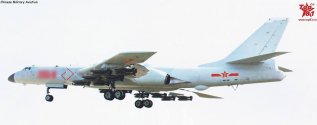
... and Flankers carrying 250kg bombs as well on six bomb multi ejector racks
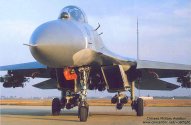
Of course, for those above pictures depicted, carrying that many bombs might not be fully realistic.
In the case of the Flanker in particular, no Flanker will ever carry that many bombs in a real mission, but even "only" carrying two multi racks of 250kg bombs will be twelve 250kg PGMs. Add on a targeting pod, a self protection jamming pod, a couple of SRAAMs and BVRAAMs and that is a very realistic strike loadout with self protection capability.
For the J-10, it will likely have to replace one of the forward intake stations with a targeting pod, and the other forward intake station with a self protection jamming pod. That leaves two dual racks and two rear fuselage stations for six total 250kg PGMs. Then there's the three EFTs and two SRAAMs, and you also get a respectable strike loadout.
For H-6K, it can actually probably take off and carry out a realistic strike mission with thirty six 250kg PGMs, especially if those PGMs have wing kits for range extension, in an environment where you mostly have air control with the enemy and plentiful supporting fighter escort and EW/ECM escort.
Heck, even if multi-racks with six 250kg bombs is too ambitious, even a triple rack for 250kg bombs will be fine, like what F-16 and Rafale have.
====
All of this is to say -- maximizing
targets successfully engaged/sortie is arguably the most important benefit of contemporary PGMs.
Maximizing targets/sortie, is enabled through:
1. Use of lower weight PGMs (mostly in the 250kg class which are sufficient for most soft and semi-hardened targets, or even better, 100kg class PGMs with built in wing kits (like SDB, SPICE 250, or Chinese products like TL-20, FT-7) that allow for ranges of about 100km....
2. Multi-ejector racks where multiple PGMs can be carried on one single pylon.
3. More advanced guidance methods -- usually combining satellite and laser guidance, but now also including more advanced terminal seekers like ImIR and MMW.
IMO, the PGM types that the PLA types would most benefit from adopting are:
- 250kg PGMs, to be carried on multi-ejector racks, six per rack for JH-7/A and J-16, perhaps triple or dual racks for J-10.They would be modular PGMs with satellite and laser guidance options and the ability to install an optional wing kit to extend range. The FT family of bombs offers this, as so:
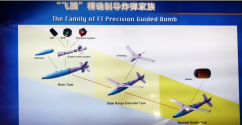
- 100kg PGMs with about 100km range. These would be Sino-SDBs. Satellite guided as standard, with ImIR terminal guidance additional. Quad racks similar to SDB, SPICE-250, SPEAR 3. A number of such systems are already offered by the Chinese aerospace industry and tested, but again they are not committed to. TL-20, YL-14, FT-7 are examples of these.
Once the PLA commits to a family of 250kg PGMs and 100kg PGMs and -- most importantly -- multi-ejector racks for them, then that would be a major sign that they are taking A2G PGM strike seriously.






